Exhibitions
2015-3 MOMAT Collection
Date
-Location
Collection Gallery, from the fourth to second floors
A special display : A Chronology of Art from a Slightly Architectural Perspective(4th–2nd floor)

Welcome to the MOMAT Collection! In this edition of the exhibit, we make use of three floors (beginning on the 4th floor and continuing down to the 2nd) of the museum to present a special feature called “A Chronology of Art from a Slightly Architectural Perspective.” Unfortunately, the museum does not collect architecture (the question of how it would be possible to collect architecture is in itself a difficult one). But in considering various historical changes in a given culture, it goes without saying that architecture is as important, if not more important, than painting and sculpture. This is because houses are connected to our lives and public buildings are (implicitly and explicitly) connected to government.
With this mind, we decided to re-examine the architecture-less museum collection from an architectural perspective. This naturally led us to works that depict the subject of architecture, works that have an affinity with architecture of the same period, and works that are completely contrary to architecture of the same period. We also realized that there were quite a few works that hit on interesting ideas prior
to their emergence in architecture. By assembling these works, and arranging them in a chronological display, we have arrived at this special feature.
Important Cultural Properties on display
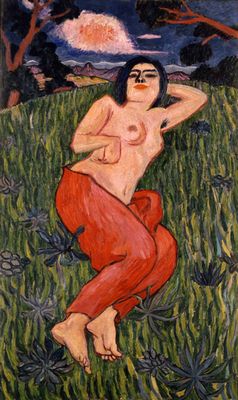
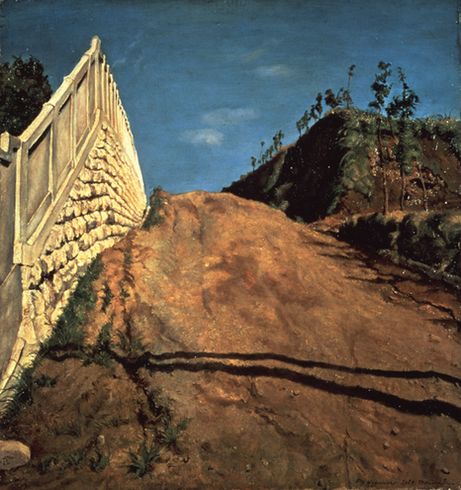
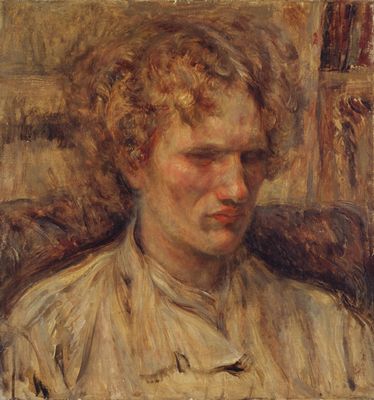
The collection at the main building of the National Museum of Modern Art, Tokyo now has thirteen pieces that are designated as Important Cultural Properties by the Japanese government, comprising eight Japanese-style paintings, four oil paintings and one sculpture.
The following Important Cultural Properties are shown in this period:
- Yorozu Tetsugoro, Nude Beauty, 1912
- Kishida Ryusei, Road Cut through a Hill, 1915
- Nakamura Tsune, Portrait of Vasilii Yaroshenko, 1920
Please visit the Important Cultural Property section Masterpieces for more information about the pieces.
About the Sections
MOMAT Collection comprises twelve(or thirteen)rooms and two spaces for relaxation on three floors. In addition, sculptures are shown near the terrace on the second floor and in the front yard. The light blue areas in the cross section above make up MOMAT Collection. The space for relaxation A Room With a View is on the fourth floor.
The entrance of the collection exhibition MOMAT Collection is on the fourth floor. Please take the elevator or walk up stairs to the fourth floor from the entrance hall on the first floor.
4F (Fourth floor)
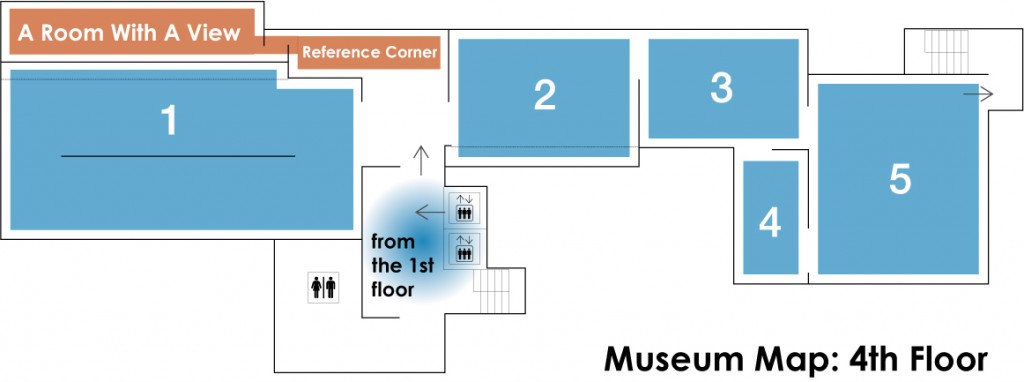
Room 1 Highlights * This section presents a consolidation of splendid works from the collection, with a focus on Master Pieces.
Room 2– 5 1900s-1940s
From the End of the Meiji Period to the Beginning of the Showa Period
A Room With A View
Reference Corner
2F (Second floor)
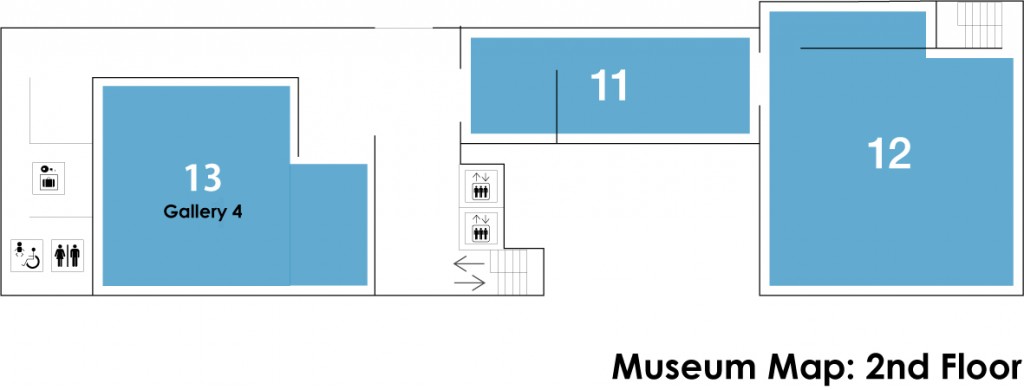
Room 11-12 1970s-2010s
From the End of the Showa Period to the Present
Gallery 4
Visiting Japan: Tourism Promotion in the 1920 and 1930s (January 9 to February 28, 2016)
- A space of about 250 square meters. This gallery offers cutting-edge thematic exhibitions from the Museum Collection, and special exhibitions featuring photographs or design.
11. Room 11 Shinohara Kazuo, House in Uehara
Shinohara Kazuo (1925–2006) was an architect. He switched from mathematics to architecture, and taught for many years at his alma mater, the Tokyo Institute of Technology. Involved in designing many residences, Shinohara wrote, “Houses are art,” in his book House Theory.
The owner of Shinohara’s important work House in Uehara was the photographer Ohtsuji Kiyoji. Shinohara designed many houses and villas for artists, including the painters Nakamura Masayoshi and Nomiyama Gyoji, and the poet Tanikawa Shuntaro. Ohtsuji, who commissioned Shinohara to design a villa for him at the foot of Mt. Asama (House with an Earthen Floor, 1963), later asked the architect to rebuild his house in Tokyo.
In the last installments of “Ohtsuji Kiyoji’s Laboratory,” a series that ran in Asahi Camera, the photographer documented the dismantling of the structure. The following year he published photographs of the newly completed house in the same magazine. Shinohara valued photography as a means of making houses, which are not public buildings, socially significant. Ohtsuji brilliantly captured the concrete column (angle brace), an important spatial feature in the highly distinctive House in Uehara which runs diagonally through the interior.
12. Room 12 Since the 1970s: In the Midst of Unceasing Development
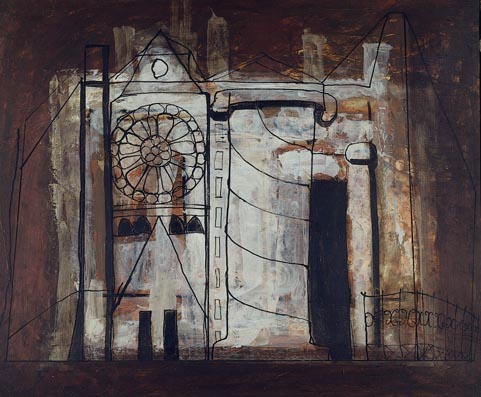
There are a few humorous examples of closed architecture from the 1970s. There are also some cases in which the architect strove to realize an abstract quality that was unique to a closed space.
As taste grew more refined in the ’80s, a movement to affirm things like barracks, which had seemed seedy up until that point, and industrial materials, which had seemed cold, emerged in architecture. A mixture of styles that had previously be seen as unattractive also came to be accepted as reflective of people and the times.
In the ’80s and ’90s, people attempted to make the most of technical advances and embraced lightness as a new aesthetic sensibility. In the midst of this unceasing development, artists and architects emerged who sought to return to the source without simply looking backward.
And two large earthquakes struck Japan, one in the west in 1995 and the over in the northeast in 2011. These natural disasters inspired updated values, and drastic changes in architectural and artistic expressions.
About the Exhibition
- Location
-
Collection Gallery, from the fourth to second floors
- Date
-
December 22, 2015 – February 28, 2016
- Time
-
10:00-17:00 (Friday is 10:00-20:00)
*Last admission is 30 minutes before closing. - Closed
-
※Closed on Mondays (except January 11, 2016 ) , December 28, 2015- January 1 and 12, 2016
- Admission
-
Adults ¥430 (220)
College and university students ¥130 (70)*Including the admission fee for MOMAT Collection and Visiting Japan: Tourism Promotion in the 1920s and 1930s.
*The price in brackets is for the group of 20 persons or more.
*All prices include tax.
*Free for high school students, under 18, seniors(65 and over), Campus Members, MOMAT passport holder.
* Show your Membership Card of the MOMAT Supporters or the MOMAT Members to get free admission (a MOMAT Member’s Card admits two persons free).
*Persons with disability and one person accompanying them are admitted free of charge. - Free Admission Days
-
*Collection Gallery and Gallery 4
Free on January 2, 3 and February 7 - Organized by
-
The National Museum of Modern Art, Tokyo


